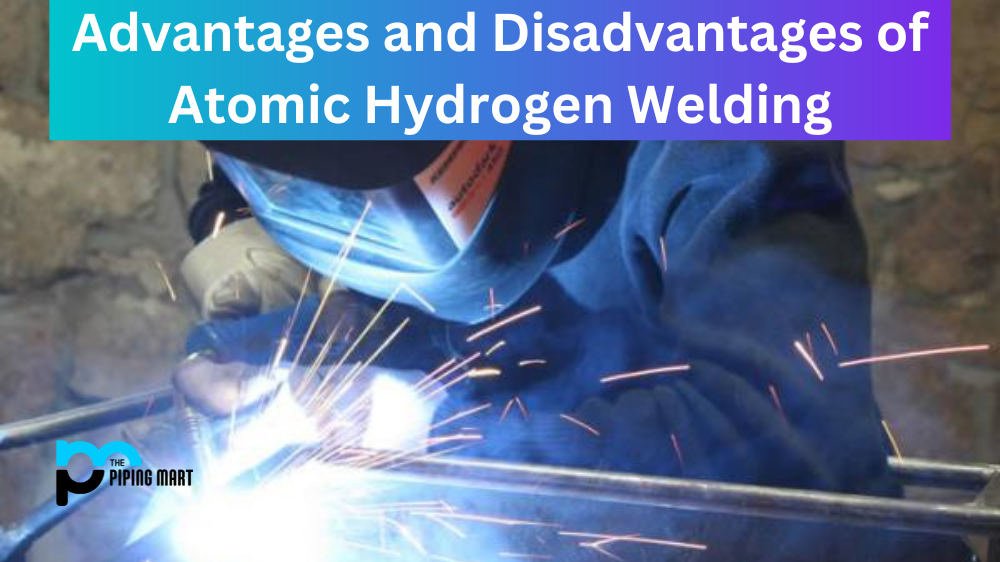Atomic hydrogen welding (AHW) is a process that uses hydrogen gas to join two metal pieces together. The process can be used in many different welding applications, but it has certain advantages and disadvantages compared to other types of welding processes. Let’s take a look at some of the pros and cons of AHW.
Advantages of Atomic Hydrogen Welding
First and foremost, AHW offers excellent weld penetration. Because the process uses a combination of hydrogen gas and an electric arc, it can penetrate deeper than other welding techniques. This makes it ideal for creating strong welds in thick materials or for joining two metal pieces together from opposite sides of the material being welded.
Another advantage of atomic hydrogen welding is that it produces relatively little slag, which means less clean-up after the welding process is complete. And because the intense heat required for AHW comes from the electric arc rather than from a torch flame, there is less risk of warping, cracking, or other heat-related damage to the metal being welded.
Greater efficiency
Atomic hydrogen welding is much more efficient than other forms of welding, such as arc welding. This is because the atomic hydrogen welds at a much higher temperature than the metal itself, which means that less heat is required to weld the metal together.
less heat input
As well as being more efficient, atomic hydrogen welding also requires less heat input. This is because the weld area is heated to a much higher temperature than with other welding methods, which means that less heat needs to be applied overall.
Cleaner welds
Atomic hydrogen welding also produces cleaner welds than other methods, as there is no metal oxide formed during the process. This means that there is less chance of contamination and that the weld will be stronger.
Faster welding speed
Another advantage of atomic hydrogen welding is that it can be performed at a much faster speed than other methods. This is because the high temperatures involved mean that the metal melts quicker, which allows for a quicker welding time.
less expensive
Finally, atomic hydrogen welding is also less expensive than other methods, as it requires less equipment and fewer consumables.
Disadvantages of Atomic Hydrogen Welding
One main disadvantage of AHW is that it requires special equipment and supplies that need to be purchased or rented before you can begin welding. This includes not only the welder itself but also items such as electrodes, electrode holders, clamps, and cooling systems to keep everything running safely during use. This can be expensive and time-consuming to set up if you don’t already have the necessary supplies on hand.
Another disadvantage is that because AHW requires an electric current to power its arc welder, you must make sure all electrical components are functioning properly before beginning any work. Otherwise, you risk damaging your equipment and/or causing an electrical fire hazard in your workspace. Additionally, using too much hydrogen gas during AHW can result in explosive reactions inside your welder’s chamber; this means extra safety precautions must be taken when using this type of welding technique to ensure no one gets hurt while operating it.
Limited Applications
One of the primary disadvantages of atomic hydrogen welding is that it has limited applications. AWH is only effective for welding metals that have a high melting point, such as tungsten, molybdenum, and tantalum. Additionally, AWH can only be used to weld metals that are in a gaseous or plasma state.
Requires High Temperatures
Another disadvantage of atomic hydrogen welding is that it requires extremely high temperatures to be effective. In order to weld metals using AWH, temperatures must be between 5,000 and 10,000 degrees Fahrenheit. This makes AWH impractical for many welding applications.
Can Be Hazardous
AWH can also be hazardous if not performed properly. The high temperatures involved in the welding process can pose a serious fire hazard. Additionally, the ultraviolet radiation emitted by the welding arc can be harmful to the eyes and skin.
Requires Specialized Equipment
AWH also requires specialized equipment that is not readily available. In order to perform AWH, a special type of welding torch is required that can generate the high temperatures needed for the welding process. Additionally, AWH can only be performed in a vacuum chamber, which further limits its practicality.
High Cost
Another disadvantage of AWH is that it is a relatively expensive welding process. The specialized equipment required for AWH can be quite costly, and the process itself is generally more time-consuming than other types of welding.
Conclusion:
Overall, atomic hydrogen welding offers a number of advantages over traditional torch-based welding processes, including better penetration capability and minimal slag build-up during operation; however, there are some drawbacks associated with this type of weldings, such as high start-up costs for special equipment as well as increased safety risks due to both electrical hazards and potential explosive reactions within the chamber. For those looking for a reliable way to join metals together quickly and efficiently without sacrificing quality or safety standards, though, atomic hydrogen welding may just be worth considering!

Abhishek is a seasoned blogger and industry expert, sharing his insights and knowledge on various topics. With his research, Abhishek offers valuable insights and tips for professionals and enthusiasts. Follow him for expert advice on the latest trends and developments in the metal industry.




